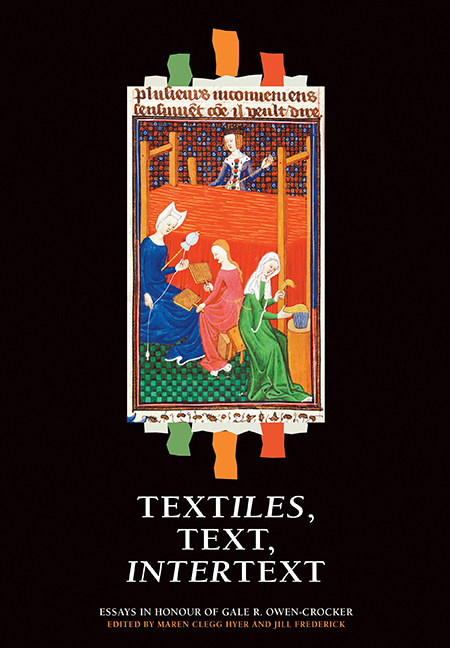Book contents
- Frontmatter
- Contents
- List of Illustrations
- List of Abbreviations
- Introduction
- A Personal Recollection
- List of publications of Gale R. Owen Crocker
- Part I Textile
- Part II Text
- 6 Text, Textile, Context: Aldhelm and Wordweaving as Metaphor in Old English
- 7 The Weft of War in the Exeter Book Riddles
- 8 Fyrenne Dracan in the Anglo-Saxon Chronicle
- 9 Old English in the Margins
- Part III Intertext
- Index
- Tabula Gratulatoria
8 - Fyrenne Dracan in the Anglo-Saxon Chronicle
from Part II - Text
Published online by Cambridge University Press: 05 July 2016
- Frontmatter
- Contents
- List of Illustrations
- List of Abbreviations
- Introduction
- A Personal Recollection
- List of publications of Gale R. Owen Crocker
- Part I Textile
- Part II Text
- 6 Text, Textile, Context: Aldhelm and Wordweaving as Metaphor in Old English
- 7 The Weft of War in the Exeter Book Riddles
- 8 Fyrenne Dracan in the Anglo-Saxon Chronicle
- 9 Old English in the Margins
- Part III Intertext
- Index
- Tabula Gratulatoria
Summary
At the beginning of the twentieth century, the well-known Norwegian polar explorer Fridtjof Nansen described his encounter with the Northern Lights:
There is the supernatural for you – the northern lights flashing in matchless power and beauty over the sky in all the colours of the rainbow! … And now from the far-away western horizon a fiery serpent writhed itself up over the sky, shining brighter and brighter as it came. It split into three, all brilliantly glittering…. Shaves of rays swept along the side of the serpents, driven through the ether-like waves before a storm wind.
One of the most captivating and suggestive celestial spectacles, the Northern Lights or aurora borealis are a display of light in the northern hemisphere caused by the interaction between the solar wind and the upper atmosphere. This ephemeral and shape-shifting astronomical occurrence remained mysterious until the nineteenth and twentieth centuries, when explorers like Nansen began to give more accurate descriptions of the phenomenon, comparing the Northern Lights to the manifold colours of the rainbow. The aurora's explosion of energy and colours and its rapid movements often cause flickering shapes in the sky, the most common described as armies in the sky, spears, torches, and fiery dragons. It is not surprising, then, that such a phenomenon would appeal to the imagination of observers, and naturally acquire a mystical dimension. Notwithstanding the nearly 1,200 years which separate the two accounts, a similar, albeit shorter and less detailed, depiction of the natural phenomenon seems to appear in what is perhaps one of the most celebrated and evocative accounts in Old English literature, the entry in the Anglo-Saxon Chronicle (henceforth ASC) for the year 793, which details the sack of Lindisfarne by the Vikings and which the chronicler deliberately associates with fyrenne dracan in the sky, and ormete þodenas 7 ligrescas:
MS D AN. dDccxciii. Her waron rede forebecna cumene ofer Nordhymbra land. tat folc earmlic bregdon: tat waron ormete todenas ligrescas, fyrenne dracan waron gesewene on tam lifte fleogende. tam tacnum sona fyligde mycel hunger, litel after tam, tas ilcan geares on. vi. idus Ianuarii7 earmlice hatenra manna hergung adilegode Godes cyrican in Lindisfarnae turh hreaflac. mansliht. Sicga fordferde on. viii. kalendas Martius.
- Type
- Chapter
- Information
- Textiles, Text, IntertextEssays in Honour of Gale R. Owen-Crocker, pp. 153 - 170Publisher: Boydell & BrewerPrint publication year: 2016



